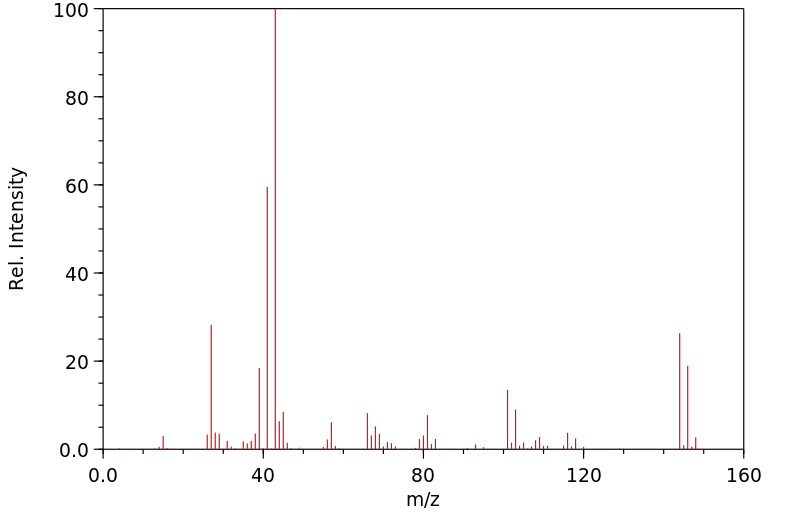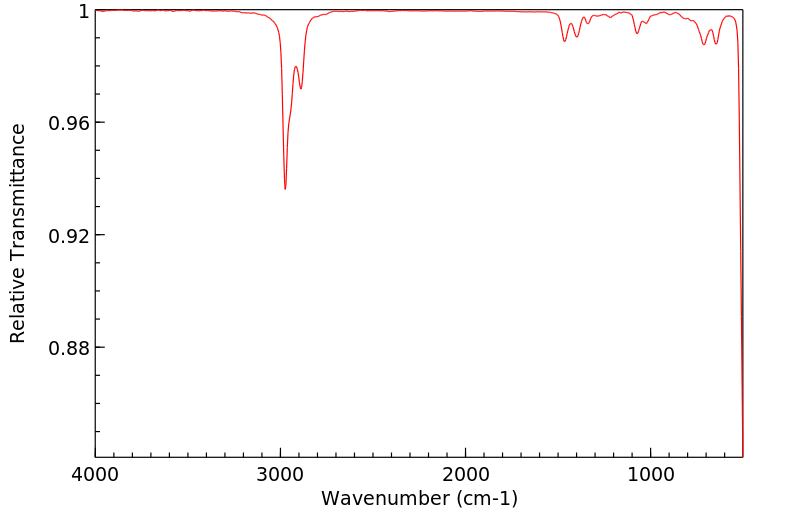dichloropropylphosphine | 15573-31-6
中文名称
——
中文别名
——
英文名称
dichloropropylphosphine
英文别名
dichloro-n-propyl phosphine;n-Propyldichlorophosphine;dichloro(propyl)phosphane
CAS
15573-31-6
化学式
C3H7Cl2P
mdl
MFCD00013618
分子量
144.968
InChiKey
PVTHAGJZMANMRT-UHFFFAOYSA-N
BEILSTEIN
——
EINECS
——
-
物化性质
-
计算性质
-
ADMET
-
安全信息
-
SDS
-
制备方法与用途
-
上下游信息
-
文献信息
-
表征谱图
-
同类化合物
-
相关功能分类
-
相关结构分类
计算性质
-
辛醇/水分配系数(LogP):2.4
-
重原子数:6
-
可旋转键数:1
-
环数:0.0
-
sp3杂化的碳原子比例:1.0
-
拓扑面积:0
-
氢给体数:0
-
氢受体数:0
安全信息
-
危险等级:8
-
安全说明:S26,S36/37/39
-
危险类别码:R14,R34
-
危险品运输编号:UN 3129
-
包装等级:II
-
危险类别:8
-
储存条件:常温下应密闭避光、存放在通风干燥且充满惰性气体的环境中。
SDS
Section 1: Product Identification
Chemical Name: n-Propyldichlorophosphine, min. 98%
CAS Registry Number: 15573-31-6
Formula: n-C3H7PCl2
EINECS Number: none
Chemical Family: organophosphine halide
Synonym: Dichloropropylphosphine, Phosphine, dichloropropyl-
Section 2: Composition and Information on Ingredients
Ingredient CAS Number Percent ACGIH (TWA) OSHA (PEL)
Title Compound 15573-31-6 100% no data no data
Section 3: Hazards Identification
Material has a pungent odor. Inhalation of vapor may cause coughing, headache, and pulmonary edema. Very
Emergency Overview:
corrosive to eyes, skin, nose, and mucous membranes.
Primary Routes of Exposure: Contact with skin and eyes. Inhalation of vapor.
Eye Contact: Causes burns to the eyes.
Causes mild to severe irritation of the skin. Hydrochloric acid hydrolysis product is a corrosive liquid or vapor.
Skin Contact:
Inhalation: Corrosive Inhalation may cause spasms, coughing, chemical pneumonitis and pulmonary edema.
Ingestion: Corrosive to mouth throat and stomach. May cause dizziness, nausea, vomiting, pain and stomach upset.
Material has a pungent odor. Inhalation of vapor may cause chemical pneumonitis and pulmonary edema.
Acute Health Affects:
Contact of liquid or vapor with eyes and skin causes burns.
Chronic Health Affects: No information available on long-term chronic effects.
NTP: No
IARC: No
OSHA: No
SECTION 4: First Aid Measures
Immediately flush the eyes with copious amounts of water for at least 10-15 minutes. A victim may need
Eye Exposure:
assistance in keeping their eye lids open. Get immediate medical attention.
Wash the affected area with water. Remove contaminated clothes if necessary. Seek medical assistance if
Skin Exposure:
irritation persists.
Remove the victim to fresh air. Closely monitor the victim for signs of respiratory problems, such as difficulty
Inhalation:
in breathing, coughing, wheezing, or pain. In such cases seek immediate medical assistance.
Seek medical attention immediately. Keep the victim calm. Give the victim water (only if conscious). Induce
Ingestion:
vomiting only if directed by medical personnel.
SECTION 5: Fire Fighting Measures
Flash Point: no data
Autoignition Temperature: no data
Explosion Limits: no data
Extinguishing Medium: carbon dioxide, dry powder or foam
If this material is involved in a fire, fire fighters should be equipped with a NIOSH approved positive pressure
Special Fire Fighting Procedures:
self-contained breathing apparatus and full protective clothing.
Hazardous Combustion and In a fire material may emit toxic organic fumes, carbon monoxide, carbon dioxide, and phosphorous pentoxide.
Decomposion Products:
Unusual Fire or Explosion Hazards: No unusual fire or explosion hazards.
SECTION 6: Accidental Release Measures
Small spills can be neutralized with powdered sodium bicarbonate, lime, or calcium carbonate and swept up.
Spill and Leak Procedures: Spillage in areas not adequately ventilated will require an evacuation of site. Emergency response teams will
require self-contained breathing apparatus.
SECTION 7: Handling and Storage
Store in a cool, dry, well-ventilated area. Keep containers tightly sealed. Transfer material under an inert
Handling and Storage:
atmosphere of nitrogen or argon.
SECTION 8: Exposure Controls and Personal Protection
Always wear safety glasses. If pouring or transferring this substance wear a face shield for additional
Eye Protection:
protection.
Skin Protection: Wear protective clothing and gloves. Consult with glove manufacturer to determine the proper type of glove.
Ventilation: Material has a pungent odor. Always handle material in an efficient fume hood.
If ventilation is not available a respirator should be worn. The use of respirators requires a Respirator
Respirator:
Protection Program to be in compliance with 29 CFR 1910.134.
Ventilation: Material has a pungent odor. Always handle material in an efficient fume hood.
Additional Protection: No additional protection required.
SECTION 9: Physical and Chemical Properties
Color and Form: colorless liq.
Molecular Weight: 144.97
Melting Point: no data
Boiling Point: 133°C
Vapor Pressure: no data
Specific Gravity: 1.118
Odor: sharp acidic odor
Solubility in Water: Reacts vigorously with water
SECTION 10: Stability and Reactivity
Stability: air sensitive, moisture sensitive
Hazardous Polymerization: no hazardous polymerization
Conditions to Avoid: contact with air or moisture
Incompatibility: Water, air, oxidizing agents, active metals, oxygen and sulfur
Decomposition Products: carbon dioxide, carbon monoxide, phosphorus oxide, hydrogen chloride, and organic fumes
SECTION 11: Toxicological Information
RTECS Data: No information available in the RTECS files.
Carcinogenic Effects: No data available
Mutagenic Effects: No data available
Tetratogenic Effects: No data available
SECTION 12: Ecological Information
Ecological Information: No information available
SECTION 13: Disposal Considerations
Disposal: Dispose of according to local, state and federal regulations.
SECTION 14: Transportation
Shipping Name (CFR): Corrosive liquids, N.O.S.
Hazard Class (CFR): 8
Additional Hazard Class (CFR): NA
Packaging Group (CFR): I
UN ID Number (CFR): UN# 1760
Shipping Name (IATA): Corrosive liquid, N.O.S.
Hazard Class (IATA): 8
Additional Hazard Class (IATA): NA
Packaging Group (IATA): I
UN ID Number (IATA): UN# 1760
SECTION 15: Regulatory Information
TSCA: Not listed in the TSCA inventory.
SARA (Title 313): Title compound not listed.
Second Ingredient: none
SECTION 16 - ADDITIONAL INFORMATION
N/A
上下游信息
反应信息
-
作为反应物:描述:参考文献:名称:Guichard, Chemische Berichte, 1899, vol. 32, p. 1574摘要:DOI:
-
作为产物:描述:参考文献:名称:Guichard, Chemische Berichte, 1899, vol. 32, p. 1574摘要:DOI:
文献信息
-
Substituted propane-phosphinic acid compounds申请人:Ciba-Geigy Corporation公开号:US05064819A1公开(公告)日:1991-11-12Compounds of the formula I ##STR1## wherein R denotes an aliphatic, cycloaliphatic, cycloaliphatic-aliphatic or araliphatic radical having 2 or more carbon atoms, and wherein one of the groups R.sup.1, R.sup.2 and R.sup.3 represents hydrogen or an aliphatic, cycloaliphatic, araliphatic or aromatic radical, another one of R.sup.1, R.sup.2 and R.sup.3 is hydrogen or, in the case of R.sup.1 and R.sup.2, is hydroxy, and the remaining one of R.sup.1, R.sup.2 and R.sup.3 is hydrogen, or wherein R denotes methyl, R.sub.1 denotes hydrogen or hydroxy, R.sub.2 denotes an aromatic radical and R.sub.3 represents hydrogen, and their salts have GABA.sub.B -antagonistic properties and can be used as GABA.sub.B -antagonists. They are obtained when in a compound of formula II ##STR2## in which R, R.sup.1, R.sup.2 and R.sup.3 have their previous significances, Z represents --NH.sub.2 and R.sup.4 denotes a hydroxy-protective group R.sup.5 or, when R.sup.1 and R.sup.3 denote hydrogen and R.sup.2 denotes hydrogen or alkyl, denotes an alkali metal or ammonium ion R.sup.6, or Z represents a protected or latent amino group Z.sup.0 and R.sup.4 denotes hydrogen or a hydroxy-protective group R.sup.5, any group R.sup.5 or R.sup.6 is replaced by hydrogen, and/or any group Z.sup.0 is converted into --NH.sub.2.公式I的化合物##STR1##其中R表示具有2个或更多碳原子的脂肪族、环脂族、环脂族-脂肪族或芳基脂肪基,其中R.sup.1、R.sup.2和R.sup.3中的一个代表氢或脂肪族、环脂族、芳基脂肪基或芳香族基,R.sup.1、R.sup.2和R.sup.3中的另一个是氢或在R.sup.1和R.sup.2的情况下是羟基,而R.sup.1、R.sup.2和R.sup.3中的剩余一个是氢,或者R表示甲基,R.sub.1表示氢或羟基,R.sub.2表示芳基,R.sub.3表示氢,它们的盐具有GABA.sub.B-拮抗性质,可用作GABA.sub.B-拮抗剂。当在公式II的化合物中获得它们##STR2##其中R、R.sup.1、R.sup.2和R.sup.3具有其先前的含义,Z表示--NH.sub.2,R.sup.4表示羟基保护基R.sup.5或者当R.sup.1和R.sup.3表示氢且R.sup.2表示氢或烷基时,表示碱金属或铵离子R.sup.6,或者Z表示受保护或潜在的氨基Z.sup.0且R.sup.4表示氢或羟基保护基R.sup.5,任何一个R.sup.5或R.sup.6基团被氢取代,和/或任何一个Z.sup.0基团被转化为--NH.sub.2。
-
Synthesis, X-ray structures and chemistry of enantiomerically pure 10,11-dihydro-5-phenyl-5H-dibenzo[b,f ]phosphepine 5-oxides作者:Paul Wyatt、Stuart Warren、Mary McPartlin、Tom WoodroffeDOI:10.1039/b006883g日期:——Several phosphepine oxides were synthesised in optically pure form. Sharpless asymmetric dihydroxylation was used to introduce the chiral centres in all cases. Ring closure was achieved using either PhPCl2 or PrPCl2 together with a double nucleophile generated by either a double ortho-lithiation or double bromineâlithium exchange. The X-ray crystal structures of three phosphepine oxides illustrate their different conformations. The NMR spectra of several phosphepine oxides are described as is the chemistry which is shown to differ from that of acyclic phosphine oxides.
-
New modular P-chiral ligands for Rh-catalyzed asymmetric hydrogenation作者:Oleg G. Bondarev、Richard GoddardDOI:10.1016/j.tetlet.2006.10.122日期:2006.12New modular P-chiral ligands have been prepared from commercially available (S)-α,α-diphenylprolinol. With these new types of ligands, up to 95% ee was achieved in the Rh-catalyzed asymmetric hydrogenation of functionalized olefins.
-
Alkyl and aryl dicationic derivatives of cyclic triphosphenium ions作者:Keith B. Dillon、Andrés E. Goeta、Judith A. K. Howard、Philippa K. Monks、Helena J. Shepherd、Amber L. ThompsonDOI:10.1039/b716027e日期:——Direct alkylation of cyclic triphosphenium ions by triflates to give di-ium dications is only possible for small organic substituents on the attacking reagent. The dicationic products are not intrinsically unstable, however, and in many instances they may be synthesised by an alternative route, pioneered by Schmidpeter and co-workers. These species may be readily identified in solution by (31)P NMR
-
The relative stabilities of cyclic dicationic derivatives of diphosphanes with three (3P) or four (4P) linked phosphorus atoms作者:Rachel Bashforth、Alice J. Boyall、Philippa K. Coffer (née Monks)、Keith B. Dillon、Andrés E. Goeta、Judith A. K. Howard、Alan M. Kenwright、Michael R. Probert、Helena J. Shepherd、Amber L. ThompsonDOI:10.1039/c1dt11549a日期:——or AlCl3 leads to the formation of dicationic heterocycles with three (3P) or four (4P) linked phosphorus atoms. Some 3P derivatives with small alkyl substituents may also be prepared by direct alkylation of cyclic triphosphenium ions. Several new species were prepared in solution, some of which were isolated and characterised by single-crystal X-ray diffraction. Investigations into the factors favouring
表征谱图
-
氢谱1HNMR
-
质谱MS
-
碳谱13CNMR
-
红外IR
-
拉曼Raman
-
峰位数据
-
峰位匹配
-
表征信息
同类化合物
甲基二碘膦
甲基二氯膦
环己二氯膦
氯化二乙基磷
氯二环戊基膦
氯二异丙基膦
氯(二甲基)膦
氯(二丙基)膦
氟二甲基磷化氢
叔丁基二氯化膦
叔丁基(二氟)膦
反式-1,2-二(二氯膦基)环戊烷
双(二氯磷氢基)甲烷
双(1-金刚烷基)氯化磷
二环己基氯化膦
二溴(二溴甲基)膦
二氯异丙基膦
二氯(氯甲基)膦
二氯(五氟乙基)膦
二叔丁基氯化膦
二丁基氯化膦
乙基氯甲基膦
乙基二溴膦
乙基二氯化磷
三甲基二氟膦烷
丁基二氯膦
[二叔丁基(氯化)膦]二氯化钯(II)二聚体
2,2'-二甲氧基庚烷
1,4-双(二氯化磷)丁烷
1,3-双(二氯膦)丙烷
1,2-双(二氯磷基)-乙烷
1,1-二乙基丙基二氯膦
-丁基氯(甲基)膦
(二氯甲基)亚膦酸二氯化物
(2,2-二甲基丙基)亚膦酸二氯化物
(1-金刚烷基)二氯膦
chloroprop-2-ynylphosphane
chlorohex-2-enylphosphane
chloro(2-methoxyprop-2-enyl)phosphane
chloro(cyclopent-1-en-1-ylmethyl)phosphane
chloro(1-isopropenylcyclopropyl)phosphane
trans-1,2-bis(dichlorophosphino)cyclohexane
cis-{ClP-(μ-NtBu)}2
1,1-Dibromethyldibromophosphin
1-Brom-1-chlorethyldibromphosphin
bis(dichlorophosphino)ethane
bis(dichloromethyl)phosphinous chloride
chlorocyclohexa-2,4-dienylphosphane
tert-butyl(chloro)cyclohexylphosphane
3-bromopropyl dichlorophosphine








